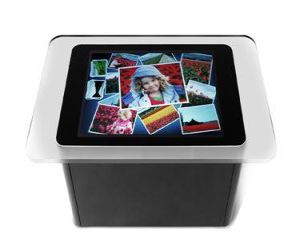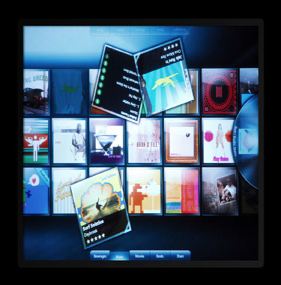What is Microsoft Surface ?
Microsoft Surface (Codename: Milan), is a forthcoming product from Microsoft which is developed as a software and hardware combination technology that allows a user, or multiple users, to manipulate digital content by the use of natural motions, hand gestures, or physical object. The product provides effortless interaction with digital content through natural gestures, touch and physical objects.
Surface is a 30-inch display in a table-like form factor that’s easy for individuals or small groups to interact with in a way that feels familiar, just like in the real world. In essence, it’s a surface that comes to life for exploring, learning, sharing, creating, buying and much more.
It was announced on May 29, 2007 at D5, and is expected to be released by commercial partners in November 2007. Initial customers will be in the hospitality businesses, such as restaurants, hotels, retail, and public entertainment venues.
Microsoft Surface Screenshots :


Microsoft Surface Description:
Surface is essentially a Windows Vista PC tucked inside a black table base, topped with a 30-inch touchscreen in a clear acrylic frame. Five cameras that can sense nearby objects are mounted beneath the screen. Users can interact with the machine by touching or dragging their fingertips and objects such as paintbrushes across the screen, or by setting real-world items tagged with special barcode labels on top of it.
Surface can simultaneously recognize dozens and dozens of movements such as touch, gestures and actual unique objects that have identification tags similar to bar codes. Surface will ship to partners with a portfolio of basic applications, including photos, music, virtual concierge and games, that can be customized to provide their customers with unique experiences.
Microsoft Surface Specifications :
Dimensions : Surface is a 30-inch (76 cm) display in a table-like form factor, 22 inches (56 cm) high, 21 inches (106 cm) deep, and 84 inches (214 cm) wide.
Body and Build : The Surface tabletop is acrylic, and its interior frame is powder-coated steel.
Installed Memory: 2 GB
Display Type: Flat panel display
Network Support: Ethernet, Fast Ethernet, Bluetooth 2.0, IEEE 802.11b, IEEE 802.11g
Operating System: Microsoft Windows Vista
Input Devices: Touch-screen
How does it Feels ?
Microsoft’s version of the multi-touch computer adds one very cool, though impractical, twist: interaction with other electronics.
For example, in Microsoft’s demonstration, you can take some pictures. When you set the camera down on the table top, the fresh photos come pouring out of it into a virtual puddle on the screen — a slick, visual way to indicate that you’ve just downloaded them.
Next, you can set a cellphone down on the table — and copy photos into it just by dragging them into the cellphone’s zone.
Then you can buy songs from a virtual music store and drag them directly into a Zune music player that you’ve placed on the glass.
What is Surface Computing ?
Surface computing breaks down traditional barriers between people and technology, changing the way people interact with all kinds of everyday content, from photos to maps to menus. The intuitive user interface works without a traditional mouse or keyboard, allowing people to interact with content and information by using their hands and natural movements.
Surface computing features four key attributes:
Direct interaction :
Users can actually "grab" digital information with their hands, interacting with content by touch and gesture, without the use of a mouse or keyboard.
Multi-touch contact :
Surface computing recognizes many points of contact simultaneously, not just from one finger as with a typical touch screen, but up to dozens and dozens of items at once.
Multi-user experience:
The horizontal form factor makes it easy for several people to gather around surface computers together, providing a collaborative, face-to-face computing experience.
Object recognition:
Users can place physical objects on the surface to trigger different types of digital responses, including the transfer of digital content.
How does Microsoft Surface work?
At a high level, Surface uses cameras to sense objects, hand gestures and touch. This user input is then processed and the result is displayed on the surface using rear projection.
- Screen: A diffuser turns the Surface's acrylic tabletop into a large horizontal "multitouch" screen, capable of processing multiple inputs from multiple users. The Surface can also recognize objects by their shapes or by reading coded "domino" tags.
- Infrared: Surface's "machine vision" operates in the near-infrared spectrum, using an 850-nanometer-wavelength LED light source aimed at the screen. When objects touch the tabletop, the light reflects back and is picked up by multiple infrared cameras with a net resolution of 1280 x 960.
- CPU: Surface uses many of the same components found in everyday desktop computers — a Core 2 Duo processor, 2GB of RAM and a 256MB graphics card. Wireless communication with devices on the surface is handled using WiFi and Bluetooth antennas (future versions may incorporate RFID or Near Field Communications). The underlying operating system is a modified version of Microsoft Vista.
- Projector: Microsoft's Surface uses the same DLP light engine found in many rear-projection HDTVs. The footprint of the visible light screen, at 1024 x 768 pixels, is actually smaller than the invisible overlapping infrared projection to allow for better recognition at the edges of the screen.
Features of Microsoft Surface:
Multi-touch display:
The Surface display is capable of multi-touch interaction, recognizing dozens and dozens of touches simultaneously, including fingers, hands, gestures and objects placed on the surface.
Horizontal orientation:
The 30-inch display in a table-sized form factor allows users to share, explore and create experiences together, enabling a truly collaborative computing experience.
Requirements for Microsoft Surface:
Standard American 110–120V power System: The Surface custom software platform runs on Windows Vista™ and has wired Ethernet 10/100 and wireless 802.11 b/g and Bluetooth 2.0 connectivity.
It’s Too early to say anything about Microsoft Surface :
How cool is all of this? Very. Unfortunately, at this point, it’s the Microsoft version of a concept car; you can ogle it, but you can’t have it. These stunts require concept cameras, concept cellphones and concept music players that have been rigged to interact with the surface computer.